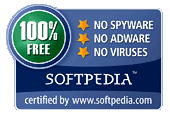Requirements
- Microsoft Windows 2000/XP/Vista/7, or Linux.
- A broadband internet connection to download the distribution's .iso file (unless you're using pre-downloaded files)
Features
UNetbootin can create a bootable Live USB drive, or it can make a "frugal install" on your local hard disk if you don't have a USB drive. It can load distributions by automatically downloading their ISO (CD image) files, or by using existing ISO files, floppy/hard disk images, or kernel/initrd files, for installing other distributions.The current version has built-in support for automatically downloading and loading the following distributions, though installing other distributions is also supported:
- Ubuntu (and official derivatives)
- 6.06 LTS
- 6.10
- 7.04
- 7.10
- 8.04 LTS
- 8.10
- 9.04
- 9.10
- 10.04
- Daily CD Images
- Debian
- Stable/Lenny
- Testing/Squeeze
- Unstable/Sid
- Linux Mint
- 3.1
- 4.0
- 5-r1
- 6
- 7
- 8
- 9
- openSUSE
- 10.2
- 10.3
- 11.0
- 11.1
- Factory
- Arch Linux
- 2007.08
- Damn Small Linux
- 4.4
- SliTaz
- Stable
- Cooking
- Puppy Linux
- 4.00
- gNewSense
- deltah-2.1
- FreeBSD
- 6.3
- 7.0
- 7.2
- 8.0
- NetBSD
- 4.0
- Fedora
- 7
- 8
- 9
- 10
- 11
- 12
- 13
- Rawhide
- PCLinuxOS
- 2010
- Sabayon Linux
- 5.1
- 5.2
- Gentoo
- 2007.0
- 2008.0
- MEPIS
- SimplyMEPIS 8
- AntiX 8
- Zenwalk
- 5.2
- Slax
- 6
- Dreamlinux
- 3.2
- Elive
- Development
- CentOS
- 4
- 5
- Mandriva
- 2007.1
- 2008.0
- 2008.1
- LinuxConsole
- 1.0.2009
- Frugalware Linux
- Stable
- Testing
- Current
- xPUD
- 0.9.2
UNetbootin can also be used to load various system utilities, including:
- Parted Magic, a partition manager that can resize, repair, backup, and restore partitions.
- SystemRescueCD, a system repair, backup and recovery tool.
- Super Grub Disk, a boot utility that can restore and repair overwritten and misconfigured GRUB installs or directly boot various operating systems
- Dr.Web Antivirus, F-Secure Rescue CD, and Kaspersky Rescue Disk, which remove malware from Windows installs.
- Backtrack, a utility used for network analysis and penetration testing.
- Ophcrack, a utility which can recover Windows passwords.
- NTPasswd, a utility which can reset Windows passwords and edit the registry.
- Gujin, a graphical bootloader that can also be used to boot various operating systems and media.
- Smart Boot Manager (SBM), which can boot off CD-ROM and floppy drives on computers with a faulty BIOS.
- FreeDOS, which can run BIOS flash and other legacy DOS utilities.
» See List of all distributions known to work with UNetbootin.
» See List of Custom UNetbootin Versions and Plugins.
» See Using a UNetbootin Plugin.
Installation & Screenshots
- If using Windows, run the file, select a distribution, floppy/hard disk image, or kernel/initrd to load, select a target drive (USB Drive or Hard Disk), then reboot once done.
- If using Linux, make the file executable (using either the command
chmod +x ./unetbootin-linux, or going to Properties->Permissions and checking "Execute"), then start the application, you will be prompted for your password to grant the application administrative rights, then the main dialog will appear, where you select a distribution and install target (USB Drive or Hard Disk), then reboot when prompted. - After rebooting, if you created a Live USB drive by selecting "USB Drive" as your install target, press the appropriate button (usually F1, F2, F12, ESC, or backspace) while your computer is starting up to get to your BIOS boot menu and select USB drive as the startup target; otherwise if there's no boot selection option, go to the BIOS setup menu and change the startup order to boot USB by default. Otherwise, if you did a "frugal install" by selecting "Hard Disk" as your install target, select the UNetbootin entry from the Windows Boot Menu as the system boots up.
Removal Instructions (Applicable only to Hard Disk / "frugal installs")
If using Windows, UNetbootin should prompt you to remove it the next time you boot into Windows. Alternatively, you can remove it via Add/Remove Programs in the Control Panel.If using Linux, re-run the UNetbootin executable (with root priveledges), and press OK when prompted to uninstall.
Removal is only required if you used the "Hard Drive" installation mode; to remove the bootloader from a USB drive, back up its contents and reformat it.
Uninstalling UNetbootin simply removes the UNetbootin entry from your boot menu; if you installed an operating system to a partition using UNetbootin, removing UNetbootin will not remove the OS.
To manually remove a Linux installation, you will have to restore the Windows bootloader using "fixmbr" from a recovery CD, and use Parted Magic to delete the Linux partition and expand the Windows partition.
Installing Other Distributions Using UNetbootin
Download and run UNetbootin, then supply it with the appropriate ISO (CD image) file, floppy/hard disk image, or kernel and initrd files when prompted (see screenshot). Check your distribution's download page to find the appropriate file; if in doubt use the ISO file.If you're loading an ISO file or floppy/hard disk image, that's all that's required (just press "OK" to start installing); otherwise if you're manually specifying kernel and initrd files and you'd like to specify special booting options, check the distribution's boot configuration files (usually after the "kernel" line in either isolinux.cfg, syslinux.cfg, menu.lst, or grub.conf) and supply them on the "Option" line.
What translations are available, and how can I use them?
A number of translations are included in the latest UNetbootin release. See the Translations Page for the status of each.If a translation corresponding to your system's native language has already been included into UNetbootin, it should automatically load the corresponding translation. Alternatively, you can force the language to use via the lang=es command-line option, where you substitute es with the the 2-letter ISO 639-1 code for your language.
If you'd like to contribute a translation, please use Launchpad Translations. If you are new to Launchpad, you will first have to join the corresponding Ubuntu Translators group for the language you intend to translate. For information on using the Launchpad Translations system, see the translations help page.
» See UNetbootin Translations
FAQs
How does UNetbootin work, and what does it do?For the Live USB creation mode, UNetbootin downloads and extracts an ISO file to your USB drive, generates an appropriate syslinux config file, and makes your USB drive bootable using syslinux.
For the Hard Disk / "frugal install" mode, UNetbootin uses a Windows or Linux-based installer to install a small modification to the bootloader (bootmgr and bcdedit on Vista, grldr and boot.ini for NT-based systems, grub.exe and config.sys for Win9x, or GRUB on Linux, uses the bootloader to boot the desired distribution's installer or to load the system utility, no CD required. After the distribution has been installed, or once done using the system utility, the modification to the bootloader is then undone.
» See USB Drive and Hard Disk Install Modes.
» See How UNetbootin Works.
Does it have any spyware, viruses, trojans, or other malware?
No; though some anti-virus products (Kaspersky) raise "Trojan.generic" warnings due to the auto-uninstall feature, these are false positives. Just make sure you obtain UNetbootin from the official downloads page on Sourceforge not some shady third-party source. If you're absolutely paranoid, you can check the source code and compile it yourself.
What is it written in, where's the source code, and how can I compile it?
UNetbootin is written in C++, using the Qt4 toolkit. Source code is available from the source zip package, or from the git repository on Sourceforge, or the bzr repository on Launchpad. The Linux version is compiled using g++, while the Windows version is cross-compiled using mingw32. Both use a statically linked version of qt4 (to eliminate external library dependencies). Executables are compressed using UPX to reduce file size.
» See Compiling UNetbootin.
How can I get my distribution supported by UNetbootin?
Create either:
- An isolinux or GRUB-based ISO file, or
- A floppy or hard disk image file, or
- A kernel and initrd file
» See List of all distributions known to work with UNetbootin.
How can I create specialized, rebranded, distro-specific releases?
UNetbootin can easily be rebranded and adapted to a specific distribution using either a plugin system, or a series of #define statements, as seen in the unetbootin.h file within the source code. If you are attempting to build a distro-specific version and need additional instructions and details, would like to have your patches merged upstream, or would like to have your custom version added to this list, please file a bug report.
» See UNetbootin Command Line Options.
» See Building a UNetbootin Plugin.
» See Using a UNetbootin Plugin.
» See Building a Custom UNetbootin Version.
» See List of Custom UNetbootin Versions and Plugins.
How can I automate the use of UNetbootin from a script?
» See UNetbootin Command Line Options.
Where can I report bugs, request new features, get help, etc?
If you encounter errors with UNetbootin itself, ask a question or file a bug report. You can also see the Ubuntu Forums (the LiveUSB installation thread or Hard disk installation thread depending on your install mode), or the forum on Boot Land, but only Launchpad (bugs and answers), not the forums, are monitored by developers. However, if it's a distribution or hardware-specific issue, file a bug report against the distribution itself.



作者已經移除這則留言。
回覆刪除Hey, pssst.
回覆刪除use sudo passwd before connecting ubuntu on the network.
Ubuntu has a flaw, it is the default root password that is probably not there. sudo was made for the live os but someone can root it so change it.